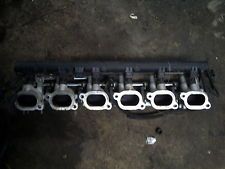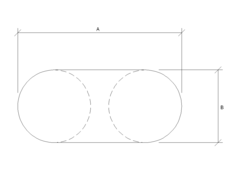
how to work out the area of an oval inlet port?
fha772 - 12/5/14 at 10:40 PM
Hi all,
I was wondering, does anyone know how I can work out the area of a BMW oval inlet port?
I've picked up a set of E46 M3 throttle bodies and I wondered how close they were in size to the circular ports on my Mercedes engine.
Here's a picture of the throttle bodies...

Cheers Frank.
stevebubs - 12/5/14 at 11:01 PM
Rough and ready simple way may be to use simple shapes....looks like you can draw a rectangle around them
Rectangle Area = Width * Height
If you then cut off the corners of the rectangle to approximate the "corners" of the ovals, the area of these can be taken away from the
above
Triangle Area = 0.5 * Width * Height.
S
fha772 - 12/5/14 at 11:04 PM
Thanks for that, it's just dawned on me, the port is a circle cut in half with a square in the middle.
If you hadn't said about looking different shapes I'd have never realised!!!
stevebubs - 12/5/14 at 11:36 PM
Glad to help 
loggyboy - 13/5/14 at 05:10 AM
As you say, ovals are elongated circles, so along with the simple rectangular calculation, use Pi R squared to give you the area of the circle,
well, 2 remaining semi circles.
[Edited on 13-5-14 by loggyboy]
rick q - 13/5/14 at 06:00 AM
If it's not a simple shape like those, you can always hold a piece of graph paper over the opening - then rub a pencil across the edge of the
port to give you the shape on the graph paper.
Count the squares and parts thereof and you have your answer for any shape.
Graph paper with thin lines at 1mm spacing and thick ones at 10mm [1 cm] spacing is readily available.
cliftyhanger - 13/5/14 at 06:31 AM
And, not wanting to reach you to suck eggs etc, don't forget it is pi x rsquared. And r is radius, not diameter. VERY easily forgotten.
ashg - 13/5/14 at 09:17 AM
Convert circumference to diameter then half to radius then pi square. Will get you pretty close. :-)
Edit. Or just measure compare the circumference of both ports
[Edited on 13/5/2014 by ashg]
mcerd1 - 13/5/14 at 10:18 AM
as above - break it down into simpler shapes...


2 *½ circle + rectangle:
=((Pi*B²)/4)+((A-B)*B)
here's a handy list for common shapes:
http://www.roymechx.co.uk/Useful_Tables/Maths/M_of_Inertia_2.html
btw if I've confused things try this:
https://www.wolframalpha.com/input/?i=solve+for+P%2C+P%3D%28%28Pi*B%C2%B2%29%2F4%29%2B%28%28A-B%29*B%29%2C++A%3D70%2C++B%3D40
(just change the 70 and 40 to your actual measurements and hit the '=' sign)
[Edited on 13/5/2014 by mcerd1]
mcerd1 - 13/5/14 at 10:21 AM
quote:
Originally posted by cliftyhanger
And, not wanting to reach you to suck eggs etc, don't forget it is pi x rsquared. And r is radius, not diameter. VERY easily forgotten.
yes Area = Pi * Radius² but thats the same as (Pi * Diamiter²)/4 or ¼*Pi*Diameter if you like 
[its ¼ because R = D/2 so R² = D²/2² and 2² = 4 ]
quote:
Originally posted by stevebubs
Rough and ready simple way may be to use simple shapes....looks like you can draw a rectangle around them
Rectangle Area = Width * Height
If you then cut off the corners of the rectangle to approximate the "corners" of the ovals, the area of these can be taken away from the
above
Triangle Area = 0.5 * Width * Height.
S
if you just tweaked that to say that the bits you cut off the corners are inverted ¼ circles you'd get this:
overall rectangle - (square B*B - circle D=B) or (A*B) - (B² - PI*B²/4)
which can be rewritten as: ((Pi*B²)/4)+((A-B)*B) - the same as above (lots of ways to skin a cat and all that...)
[Edited on 13/5/2014 by mcerd1]
b14wrc - 13/5/14 at 11:34 AM
Would you not want the round ports to matchh up with the manifold ports?
Surely going from an oval to a circle will cause flow problems?
Rob
fha772 - 13/5/14 at 11:57 AM
I'm going to make an adapter manifold/spacer to go from oval to round, but I just want to know if they are of similar size first, so I know
whether or not to port the head to match the flow rates up.
HowardB - 13/5/14 at 01:09 PM
the area of a true elipse is the average of the area of the circles formed by the major and minor radii,...
just saying,.. 
oh and for a really simple check, draw round it on squared graph paper, and then count the squares 
loggyboy - 13/5/14 at 01:12 PM
quote:
Originally posted by HowardB
the area of a true elipse is the average of the area of the circles formed by the major and minor radii,...
just saying,.. 
oh and for a really simple check, draw round it on squared graph paper, and then count the squares 
Ovals arent Elipses though.
[Edited on 13-5-14 by loggyboy]
mcerd1 - 13/5/14 at 01:13 PM
quote:
Originally posted by HowardB
the area of a true elipse is the average of the area of the circles formed by the major and minor radii,...
just saying,.. 
yeah, but thats not the shape of the BMW manifold in the pic 
loggyboy - 13/5/14 at 01:23 PM
quote:
Originally posted by mcerd1
quote:
Originally posted by HowardB
the area of a true elipse is the average of the area of the circles formed by the major and minor radii,...
just saying,.. 
yeah, but thats not the shape of the BMW manifold in the pic 
oh yeah - hadnt spotted that on the small res picture.
b14wrc - 13/5/14 at 02:39 PM
Adaptor sounds good.
Could you not port the head to match the manifold or the other way round?
Ugg10 - 13/5/14 at 03:07 PM
quote:
Originally posted by fha772
I'm going to make an adapter manifold/spacer to go from oval to round, but I just want to know if they are of similar size first, so I know
whether or not to port the head to match the flow rates up.
If that is the case then you need to be looking at the circumference. The area is a good check to make sure you are not imposing too much restriction
in the system.
Just to explain - if you start off with a round tube that has the same area/radius as the Merc inlet and then squish it to be the same shape as the
BMW TBs, the area at the BMW end will be smaller (going to the extreem of squiching it flat with zero area but the same circumference). So I would
tend to choose to start at the BMW TB end, measure/calculate the circumference and then back calculate the diametre of round tube you need to buy in
order for the squished end to match the TB once moulded in to the "oval". This may end up with a mismatch at the Merc end though. The
alternative to get both ends to match perfectly will be to start to cut, bend and weld flat sheet or cut/weld some tubes to form the manifold/adaptor.
Do the calcs and see how close you are.
Just my 2p worth.




